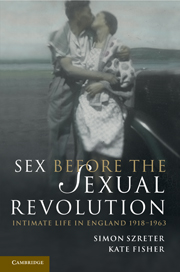Book contents
- Frontmatter
- Contents
- Acknowledgements
- 1 Introduction
- Part I What was sex?
- Part II What was love?
- Part III Exploring sex and love in marriage
- 10 Conclusion: private lives
- Appendix A The oral history sample: summary of project design and socio-demographic characteristics of the interviewees in Blackburn and north-west Hertfordshire
- Appendix B Note on social classification of the respondents
- Appendix C
- Bibliography
- Index
- Index of interviewees
10 - Conclusion: private lives
Published online by Cambridge University Press: 05 June 2012
- Frontmatter
- Contents
- Acknowledgements
- 1 Introduction
- Part I What was sex?
- Part II What was love?
- Part III Exploring sex and love in marriage
- 10 Conclusion: private lives
- Appendix A The oral history sample: summary of project design and socio-demographic characteristics of the interviewees in Blackburn and north-west Hertfordshire
- Appendix B Note on social classification of the respondents
- Appendix C
- Bibliography
- Index
- Index of interviewees
Summary
Throughout the early and mid-twentieth century, various progressive critiques of sex emerged which, despite their differences, denounced silence and secrecy surrounding sex as conducive to ignorance, inhibitions, incompetence, intolerance and sexually unsatisfying marriages. From the beginning of the twentieth century, radical and conservative voices alike increasingly saw sexual satisfaction as a cornerstone of marriage and urged couples, especially men, to educate themselves in improved sexual technique. Sexologists and marriage reformers called for men and women to become sexually literate and able to communicate such knowledge in the quest for sexual ecstasy. This critical viewpoint has informed and stimulated various sexual debates and transformations throughout the twentieth century particularly since the 1960s when the (contested) idea of ‘liberation’ was heralded as a break from the ‘repression’ of the past. In all these debates the enemy was the restricted, taboo sexuality of the past, which from the beginning of the twentieth century became labelled ‘Victorian’ but which was seen as having a lingering impact on individuals' attitudes and practices long into the twentieth century.
In addition this interpretation has framed the ways in which historians have examined the sexual cultures of the past century. They have studied these debates and gone on to question the extent to which individuals' own lives were transformed in response. They have also been influenced by the intellectual and conceptual framework of twentieth-century constructions of sexuality.
- Type
- Chapter
- Information
- Sex Before the Sexual RevolutionIntimate Life in England 1918–1963, pp. 384 - 387Publisher: Cambridge University PressPrint publication year: 2010



